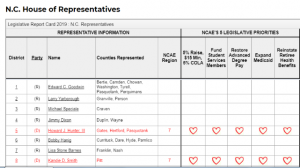[slideshow_deploy id=’18995′]
On May 1, 2019, thousands of teachers, administrators, bus drivers and counselors across the state marched through downtown Raleigh to rally for higher wages, degree compensation, and retiree health benefits.

Sea of Red: Last Year’s Teacher March
By: Elaina Bruno – Staff Writer
On May 11, 2018, thousands of teachers and students alike flooded downtown Raleigh as a sea of red. Now as May approaches once again, a rallying cry for another march is spreading throughout North Carolina. This time, the gathering holds even more importance. Angela Scioli — a Wake County teacher who founded Red4EdNC — wrote a post on the Red4EdNC blog detailing the importance of this year’s rally, specifically highlighting that “it [the march] gave undeniable, visual evidence that something is very wrong in NC.”
Scioli found that many teachers were hesitant about joining the teacher march this year because they thought there wasn’t much of an impact. However — as Scioli details in her post — the march last May illuminated how serious the problem in North Carolina truly is. This year’s march will not only continue to bring light to teacher’s concerns but is also more organized than last year and ensures teacher protection if they decide to participate.
On a Wednesday in May, the streets of downtown Raleigh will be transformed into a sea of red — consisting of both teachers and students in solidarity — united for a better tomorrow. Marches like these are what inspires change in the community but that change can only occur when there is constant pressure to make it happen.
As Scioli put it in her post, the power the teachers of this state have will only be effective if they “build it, and use it, or lose it.”
The march itself was more organized than last year. There were plenty of organizers ready to help anyone find their group, the pack of Leesville teachers stayed close together, and the sectioned waves each brought their own music and flare to the march. Counties were divided into zones, with large signs telling people to where they needed to go, and there were officers directing the foot traffic to ensure safety for everyone involved. This year may have been more organized, but the cry of change was just as wild; if anything it was louder than ever before.
Teacher Rallies Across the United States
By: Isabel Dauman – Senior Editor
Scioli– Educator, Advocate, and Education Advocate
By: Jannah Said – Staff Writer

Any student who’s taken AP GoPo or American History with Mrs. Angela Scioli can attest to her undebatable passion and motivation when it comes to the process of changemaking — whether in the classroom or on the streets of downtown Raleigh. In fact, Scioli is one of the founding members of Red4EdNC, the organization primarily responsible for initiating and running the Education March that took place on May 1st.
She is committed to teaching, and her role in advocating for public schools across the state demonstrates her devotion to the students of North Carolina.
However, a majority of people have misconceptions about the purpose of the march. The May 1 protesters did not march simply to demand higher teacher pay. Instead, they were promoting and supporting Red4Ed’s 5 Priority Agenda, which would ultimately impact the entire state.
- Provide a $15 minimum wage for all school personnel, a 5% raise for all certified staff, and a 5% cost of living adjustment for all retirees.
As a state, North Carolina is currently ranked 37th in the nation in terms of average teacher pay. Red4EdNC aimed to recognize bus drivers as the hidden backbone of the public school system and bring attention to their extremely low wages.
- Provide enough school librarians, psychologists, social workers, counselors, nurses, and other health professionals to meet national standards.
“On May 1st, I talked to the chair of the Senate Education Committee, and clearly they had a lot of talking points that had been distributed by leadership — one of which, for example, was that we’re 14th in the nation in mental health ratios for our counselors and students,” said Scioli. “I don’t care what our ranking is; I just know what our needs are in my building. So, as long as our kids’ needs are being met, we’ll be satisfied. But we’re not at a place where our kids’ needs are being met right now. So we’re going to keep pushing until our students get what they need.”
- Expand Medicaid to improve the health of students and families.
If Red4EdNC’s goal to expand Medicaid succeeded, it would lead to the protection of about 500,000 people in the state who “currently do not have access to basic health coverage,” said Scioli. Medicaid, funded jointly by states, provides healthcare to eligible low-income adults, children, pregnant women, elderly adults, and people with disabilities.
- Reinstate state retiree health benefits eliminated by the General Assembly in 2017.
The state’s final budget for 2017 eliminated health benefits for teachers and other state employees hired after 2021. North Carolinians are concerned that the new withdrawal of protection will discourage the younger generation for pursuing state employee careers.
- Restore advanced degree compensation stripped by the General Assembly in 2013.
Senate Bill 28, filed on February 6, would restore masters’ pay for teachers as long as the advanced degree was in the same subject they were teaching. The bill has passed its first reading, but has not yet been voted on. NC is in the minority when it comes to advanced degree compensation— 88% of school districts included in the National Council on Teacher Quality Teacher Contract Database provide extra pay for Masters’ degrees. The threat of debt and high expenses are discouraging many teachers from pursuing higher education– a danger that, according to the May 1st protesters, unfairly deprives students of access to teachers with more training, experience, and knowledge in their given subject.
“We have been working since 2013 to advance the agenda to support public schools and create better working and learning conditions for students and teachers,” said Scioli. Red4EdNC functions in association with 3 partners: North Carolina Association of Educators, Organize 2020, and North Carolina Teachers United.
On May 1, teachers and staff members successfully shut down 33 school systems across the state. This year’s march also included participation from bus drivers, custodians, and cafeteria personnel as well as teachers.
“Our target audience is anyone who loves North Carolina and wants us to have a bright and sustainable future, because we’re teaching the future of our republic,” said Scioli. “[The students and staff members] need to be well educated, and healthy, and be able to focus on the significant problems that are on the horizon that we will need to deal with in an educated way, given the fact that we have a representative government.”
|
|
As the morning progressed, the crowd grew larger as teachers, students and counselors prepared to chant and march towards Halifax mall. Leaders wore green and held megaphones to guide participants in to the appropriate areas. Angela Scioli, a social studies teacher at Leesville Road High School lead the teachers of Leesville.
|
|
Copies of chants were shared before the event and Angela Scioli led a chant practice before the march began. These chants quickly spread as hundreds raised their voices in solidarity.
|
|
The crowd gathered at Halifax mall where marchers were divided by their individual counties. Participants rested in the shade or danced to express their energy. Here, the marchers waited for speakers such as governor Roy Cooper and other representatives that had a stance on the topic.
Red4Ed Representative Report Card
By: Lyric Chassin – Staff Writer
The Red4EdNC website has a feature where you can view the list of North Carolina Representatives and Senators and see who agrees with what. The layout of the list in the form of a report card; it makes it easy for anyone to scroll through and read. The list includes the names, district, party, contact information, and much more for each person. There is a heart placed underneath every category next to their name when people voted for the NCAE legislative priorities. If they only voted for a specific one, hearts are placed under the ones they did vote for. The list is updated automatically every 5 minutes, so it’s simple to stay in the loop.
House of Representatives Report Card: There are 11 members in the North Carolina House of Representatives that represent Wake County. All of them voted in favor of the five legislative priorities of NCAE except for one– Darren G. Jackson. All of the Wake County representatives are democrats including Jackson. He didn’t vote for for any of the five concerns; he is the lone wolf in the group of Wake representatives.
Senate Report Card: There are five people in the North Carolina Senate representing Wake County. Two of the five did not vote in favor to the NCAE five legislative priorities. The two members are Dan Blue and John M. Alexander JR., who also represents Franklin county. The other three senators voted in favor for all the wants of the NCAE.
Nickel Wants Change
By: Jannah Said – Staff Writer

Those advocating for higher allocation of funds, attention, and resources to public schools have received mixed levels of support from government officials. However, Wiley Nickel– North Carolina state senator representing the state’s 16th district– has gone out of his way to demonstrate his support of Red4EdNC’s agenda and the public school system as a whole.
Although it’s only his first year in office, Nickel has made his intentions, goals, and values clearly evident. He has reached out to teachers, students, and lobbyists in an effort to learn more about the citizens he represents.
In fact, Nickel himself attended the Education March on Wednesday, and even went the extra mile to sport a Red4EdNC T-shirt. Furthermore, he provided boxed lunches in an air-conditioned room near his office for teachers, students, parents, and children who marched in the heat.
“The response from the North Carolina General Assembly has been totally inadequate,” said Wiley Nickel of Red4EdNC’s concerns and agenda. He believes the march was the best method for advocates to demand change. “NC in one of three states that does not allow public sector employee collective bargaining (I filed a bill to remove that prohibition) so [NC teachers and public school faculty members] are not allowed to have a union negotiate on their behalf. They are only left with marches like this as a way to make their positions known.”
The target audience of the protesters was state legislators such as Nickel, who are responsible for state budgeting, lawmaking, and prioritizing. Red4EdNC provides a constantly-updated “report card” with information on which state government officials have expressed support of or committed to the protest’s 5 demands. According to Nickel, the best outcome would be for the majority of NC legislators to agree to establish public schools as a priority and take heed of the 5 priorities.
“I’ve introduced over 70 bills,” said Nickel. “Many of them support initiatives for educators and public education in general. In the end, the best way I may be able to truly support educators is by sustaining a budget veto by Governor Cooper if it comes to that.”
Red4Ed’s Angela Scioli
|
Maddy Leen Weigh’s in as a Future Teacher
|
Why I marched on May 1
By: McKenna Daley — senior editor

I come from a long line of educators: my grandma taught English, my uncle was an instructor in the military, my mom is a school counselor, and my sister is graduating with a degree in elementary education. Having all of these amazing people as role models has inspired me to follow in their footsteps by becoming a teacher.
Because of my career aspirations, I marched through downtown Raleigh on May 1. I did this for several reasons.
One reason is because I wanted to support the teachers and family that have made an impression on me. I have had the privilege of learning from many exceptional educators, and I wanted to march in support of them and their efforts. Teachers spend countless hours before and after school creating engaging lessons and grading work. Then, on their days off, they choose to go downtown and protest for their students. Teachers do so much and protested for students like me, so I felt compelled to march in solidarity with them.
Another reason I marched is for my future students. The reason for all the May 1 activities was to try and get more resources for students — school supplies, more support staff like nurses, counselors and social workers. All of these enrich students’ educations and help them grow into healthy adults. I don’t want my future students to be in a school shooting and if there are more mental health professionals in schools, kids will get the help they need and prevent a downward spiral that propels someone to commit such a heinous act. Other resources like more librarians and updated textbooks will help students be successful. Newer textbooks will aid kids in studying and learning new material, and they won’t have to skip sections of the book because it is so outdated.
The march on May 1 holds a special place in my heart, and I hope to continue being active with NCAE.
What NC Legislators Think of Red4Ed Policies
By: Maddie Bimonte – Staff Writer


